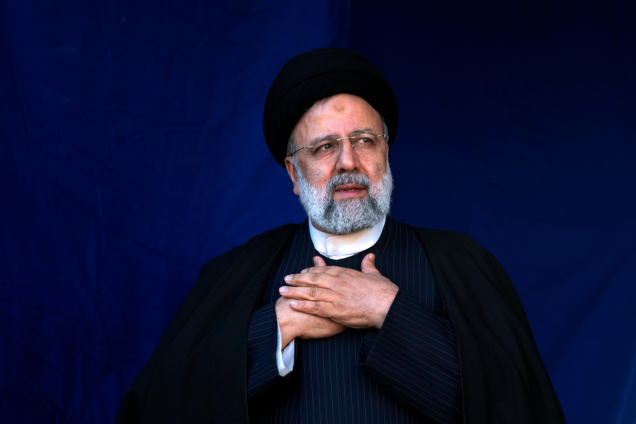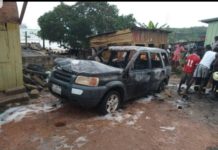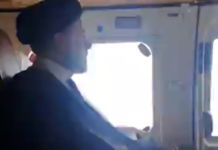
Ebrahim Raisi stood close to the pinnacle of power in the Islamic Republic and was widely tipped to rise to its very top.
A dramatic turn dealt him a different hand.
His death in a helicopter crash on Sunday has upended the growing speculation over who will eventually replace the 85-year-old Supreme leader, Ayatollah Ali Khamenei, whose own health has long been the focus of intense interest.
The tragic fate of Iran’s hardline President is not expected to disrupt the direction of Iranian policy or jolt the Islamic Republic in any consequential way.
But it will test a system where conservative hardliners now dominate all branches of power, both elected and unelected.
“The system will make a massive show of his death and stick to constitutional procedures to show functionality, while it seeks a recruit who can maintain conservative unity and loyalty to Khamenei,” observes Dr Sanam Vakil, director of the Middle East and North Africa programme at the Chatham House think tank.
Raisi’s opponents will hail the exit of a former prosecutor accused of a decisive role in the mass execution of political prisoners in the 1980s which he denied; they will hope the end of his rule hastens the end of this regime.
For Iran’s ruling conservatives, the state funeral will be an occasion freighted with emotion; it will also be an opportunity to start sending their signals of continuity.
Another critical position which must be filled is the seat held by this middle-ranking cleric on the Assembly of Experts, the body empowered to choose the new supreme leader, when that far more consequential transition comes.
“Raisi was a potential successor because, like Khamenei himself when he became supreme leader, he was relatively young, very loyal, an ideologue committed to the system who has name recognition,” says Dr Vakil of this opaque process of selection, where a number of names are seen to be in the running including the Supreme Leader’s son Mojtaba Khamenei.
Even before Raisi’s death was officially confirmed, the Ayatollah conveyed in a post on X that “the Iranian people should not worry, there will be no disruption in the country’s affairs.”
The more immediate political challenge will be staging early presidential elections.
Power has been transferred to Vice-President Mohammad Mokhber; new elections must be held within 50 days.
This appeal to voters will come just months after March’s parliamentary elections revealed a record low turnout in a country which once prided itself on strong enthusiastic participation in this exercise.
Recent elections, including the contest in 2021 which brought Raisi to the presidency, were also marked by the systematic exclusion of moderate and pro-reform rivals by the oversight body.
“Early presidential elections could provide Khamenei and the upper echelons of the state with an opportunity to reverse that trajectory to give voters a way back into the political process,” says Mohammad Ali Shabani, editor of London-based news website Amwaj.media.
“But, unfortunately, so far we have seen no indications of the state being ready and willing to take such a step.”
But, even within Raisi’s ranks, there appears to be no obvious successor.
“There are different camps within this conservative group, including individuals who are more hardline and others regarded as more pragmatic,” points out Hamidreza Azizi, a visiting fellow at SWP, the Berlin-based think tank.
He believes this will intensify the current jockeying for position within the new parliament and at local levels.
Whoever assumes Raisi’s mantle inherits a forbidding agenda and limited levers of power.
Ultimate decision-making authority in the Islamic Republic lies with the Supreme Leader.
Foreign policy, especially in the region, is the preserve of the Islamic Revolution Guard Corps (IRGC) who wield growing power.
The president didn’t call the shots months ago when Iran confronted unprecedented tensions with its arch-enemy Israel over the devastating Israel Gaza war.
It triggered a dangerous tit-for-tat and set alarm bells ringing in many capitals, most of all Tehran, over the potential for an even riskier escalatory spiral.
But as he presided over day-to-day business, Iranians struggled to cope with deepening financial hardship linked to crippling international sanctions as well as mismanagement and corruption.
Inflation soared to more than 40%; the rial currency plunged in value.
On his watch, the Islamic Republic was also shaken by an extraordinary wave of protests sparked by the death in custody in September 2022 of 22-year-old Mahsa Amin who was detained by morality police for allegedly violating Iran’s strict dress code.
Weeks before the unrest, Raisi had ordered a tightening of Iran’s “hijab and chastity law” which obligated women to behave and dress modestly including wearing a headscarf.
But the protests spearheaded by a young generation of women, lashing out against a raft of restrictions imposed on their lives, mainly focused their fury on the real sources of power, the Supreme Leader and the system itself.
Human rights groups say hundreds were killed in the crackdown and thousands detained.
“Having been elected with the lowest recorded turnout in presidential elections in Iranian history, Raisi did not have the popular mandate of his predecessor Rouhani,“ says Shabani in reference to the reformist leader Hassan Rouhani whose initial popularity was partly fuelled by the 2015 landmark nuclear deal which fell apart when President Trump unilaterally pulled the US out three years later.
Indirect talks between President Biden’s administration and Raisi’s team made little progress.
“He avoided much of the ire which was directed at Rouhani by opponents of the Islamic Republic, partly because he was simply seen as less influential and effectual,” explains Shabani.

The helicopter crash also took the life of Iran’s Foreign Minister Hossein Amir-Abdollahian who played an active role in trying to present Tehran’s case to the world and find ways to ease the punishing impact of sanctions.
During the urgent diplomacy around the Israel-Gaza war, he was the voice on the phone and the face at meetings with Iran’s allies, as well as with Arab and Western foreign ministers anxious to calm and contain tensions.
“He was a useful channel to pass messages,” commented a senior Western diplomatic source. “But it tended to be quite formulaic since power did not lie in the foreign ministry.”
“The sudden death of a president is normally a consequential event but, despite being seen as a potential Supreme Leader, he lacked political support and any clear political vision,” maintains analyst Esfandyar Batmanghelidj, CEO of the Bourse and Bazaar think tank. “But the political operators who got him elected will adjust and advance without him.”
READ ALSO:
- Iran declares 5 days of moruning after President, Foreign Minister dies in helicopter crash
- Iranian President Ebrahim Raisi killed in helicopter crash





![Iran’s president feared dead as no sign of life spotted at helicopter crash site Ebrahim Raisi was elected president in 2021 at his second attempt [File: Kim Ludbrook/Pool via AP]](https://www.adomonline.com/wp-content/uploads/2024/05/image_2024-05-20_033931936-218x150.png)

